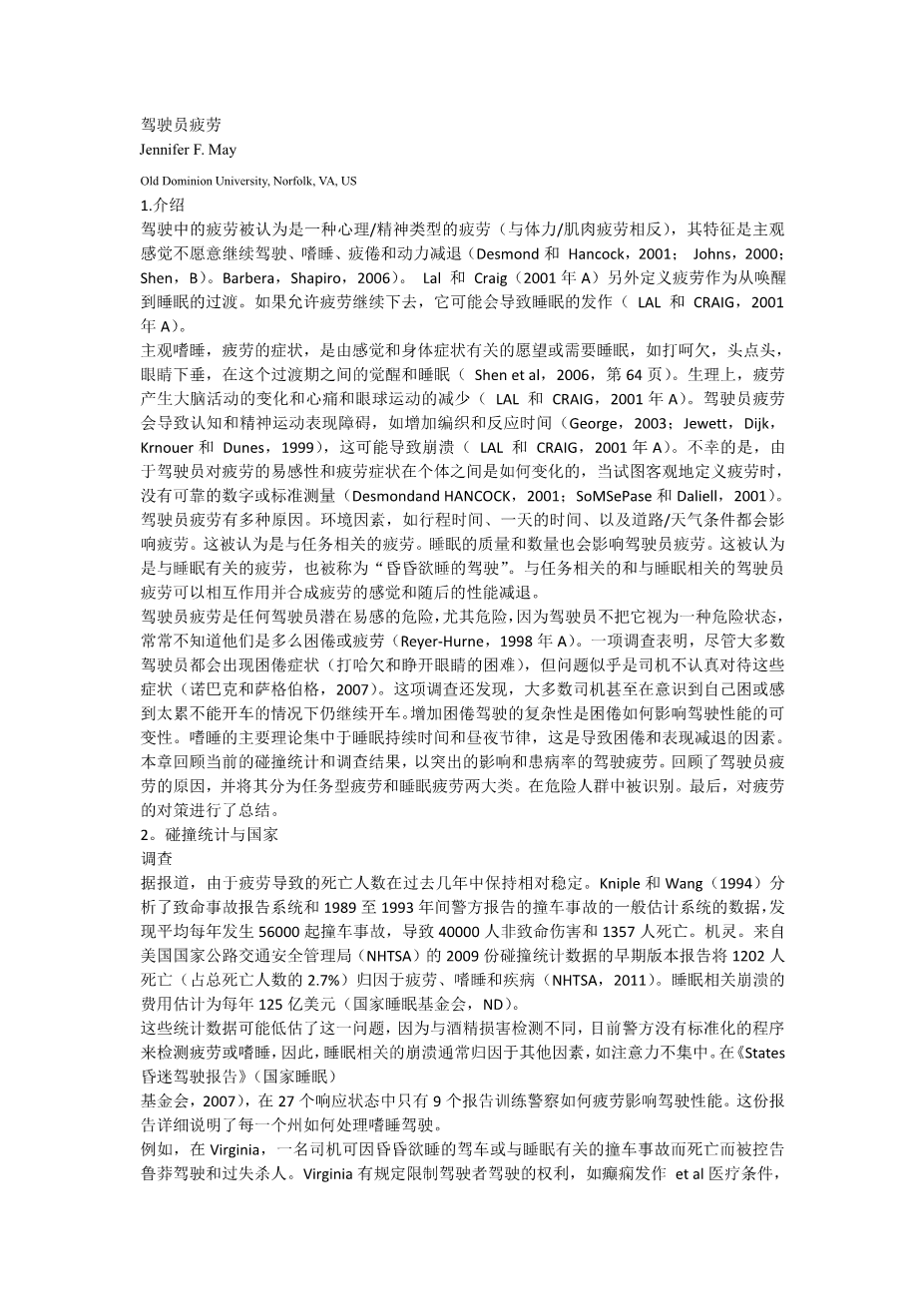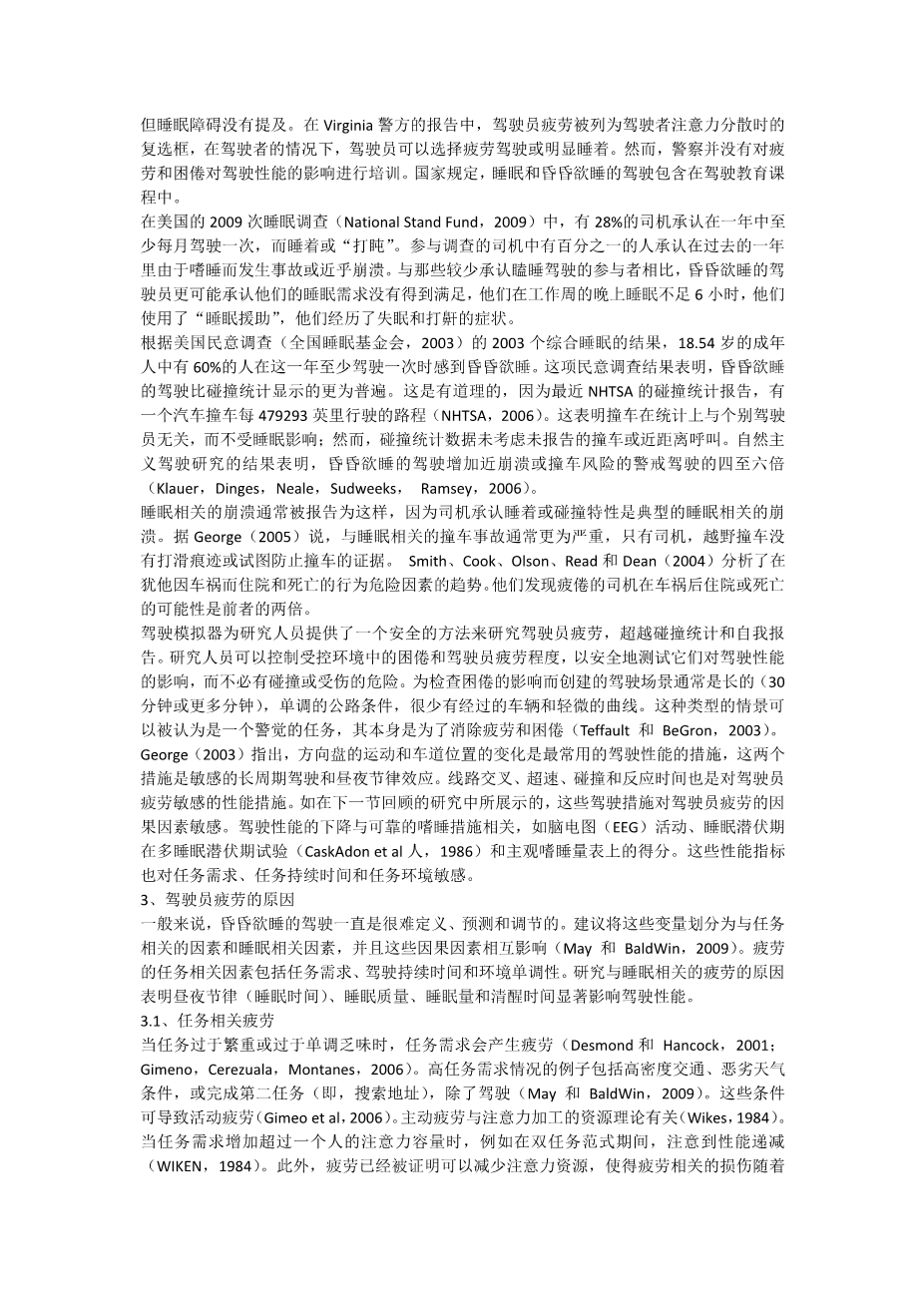Driver Fatigue
Jennifer F. May
Old Dominion University, Norfolk, VA, USA
1. INTRODUCTION
Fatigue in the context of driving is considered a psychological/mental type of fatigue (as opposed to physical/ muscle fatigue) characterized by subjective feelings of a disinclination to continue driving, sleepiness, weariness, and reduced motivation (Desmond amp; Hancock, 2001 ; Johns, 2000; Shen, Barbera, amp; Shapiro, 2006). Lal and Craig (2001a) additionally define fatigue as the transition from wake to sleep. If fatigue is allowed to continue, it may lead to episodes of sleep (Lal amp; Craig, 2001a).
Subjective sleepiness, a symptom of fatigue, is defined by the feelings and physical symptoms related to the desire or need to sleep, such as yawning, head nodding, and eye drooping, during this transitional period between wake and sleep (Shen et al., 2006, p. 64). Physiologically, fatigue produces changes in brain activity and a reduction in heartrate and eye movements (Lal amp; Craig, 2001a). Driver fatigue can result in cognitive and psychomotor performance impairments such as increased weaving and reaction time (George, 2003; Jewett, Dijk, Kronauer, amp; Dinges, 1999), which can lead to crashes (Lal amp; Craig, 2001a). Unfortunately, because of the variability in driver susceptibility to fatigue and how symptoms of fatigue can vary among individuals, there are no firm numbers or standard measurements when trying to objectively define fatigue (Desmond amp; Hancock, 2001; Soames-Job amp; Dalziel, 2001).
There are multiple causes to driver fatigue. Environmental factors such as trip duration, time of day, and roadway/weather conditions can impact fatigue. This is considered task-related fatigue. The quality and quantity of sleep will also impact driver fatigue. This is considered sleep-related fatigue and also known as “drowsy driving.” Task-related and sleep-related driver fatigue can interact and compound the feelings of fatigue and the subsequent performance decrements.
Driver fatigue is a hazard to which any driver is potentially susceptible, and it is especially dangerous because drivers do not view it as a hazardous condition and often do not realize how sleepy or fatigued they are (Reyner amp; Horne, 1998a). A survey indicated that although most drivers experience symptoms of sleepiness ( yawning and difficulties keeping eyes open), the problem appears to be that drivers do not take these symptoms seriously (Nordbakke amp; Sagberg, 2007). This same survey also found that most drivers continue to drive even when they recognize they are sleepy or feel too tired to drive. Adding to the complexity of drowsy driving is the variability in how sleepiness affects driving performance. Major theories of sleepiness focus on sleep duration and circadian rhythms as factors contributing to sleepiness and performance decrements.
This chapter reviews current crash statistics and survey results to highlight the impact and prevalence of driver fatigue. It reviews causes of driver fatigue, and these are divided into task-related fatigue and sleep-related fatigue. At-risk populations are identified. Finally, countermeasures to fatigue are summarized.
2. CRASH STATISTICS AND NATIONAL
SURVEYS
The reported number of fatalities due to fatigue has remained relatively stable throughout the years. Knipling and Wang (1994) analyzed data from the Fatal Accident Reporting System and the General Estimates System for police-reported crashes occurring from 1989 to 1993 and found that an annual average of 56,000 crashes resulting in 40,000 nonfatal injuries and 1357 fatalities were attributed to drowsiness. The early edition report of 2009 crash statistics from the National Highway Traffic Safety Administration (NHTSA) attributed 1202 fatalities (2.7% of total fatalities) to fatigue, sleepiness, and illness (NHTSA, 2011). The cost of sleep-related crashes is estimated at $12.5 billion per year (National Sleep Foundation, n.d.).
Handbook of Traffic Psychology. DOI: 10.1016/B978-0-12-381984-0.10021-9 287 Copyright 2011 Elsevier Inc. All rights reserved. |
These statistics may underestimate the problem because unlike alcohol impairment detection, there are currently no standardized procedures for the police to detect fatigue or sleepiness, and as such, sleep-related crashes are often attributed to other factors, such as inattention. In the State of the States Report on Drowsy Driving (National Sleep
Foundation, 2007), only 9 out of 27 responding states reported training police officers on how fatigue impacts driving performance. This report gave specifics for each state in how each deals with sleepy driving.
In Virginia, for example, a driver can be charged with reckless driving and manslaughter in the event of a fatality resulting from drowsy driving or sleep-related crash. Virginia has provisions limiting a driver’s right to drive based on medical conditions such as seizure disorder, but sleep disorders are not mentioned. On the Virginia police report, driver fatigue is listed as a check-box option under Driver Distractions, and in the Condition of Driver section, the officer can choose Driver Fatigued or Apparently Asleep. However, there is no training for police on the impact of fatigue and sleepiness on driving performance. The state does mandate that sleep and drowsy driving is included in the driver education curricula.
In the 2009 Sleep in America Poll (National Sleep Foundation, 2009), 28% of drivers admitted to falling asleep or “nodding off” while driving at least once per month during the year. One percent of drivers participating in the survey admitted to having an accident or near-crash due to sleepiness within the past year. Compared to participants who admitted to drowsy driving less frequently, drowsy drivers were more likely to admit that their sleep needs were n
剩余内容已隐藏,支付完成后下载完整资料


英语译文共 15 页,剩余内容已隐藏,支付完成后下载完整资料
资料编号:[464646],资料为PDF文档或Word文档,PDF文档可免费转换为Word
以上是毕业论文外文翻译,课题毕业论文、任务书、文献综述、开题报告、程序设计、图纸设计等资料可联系客服协助查找。


